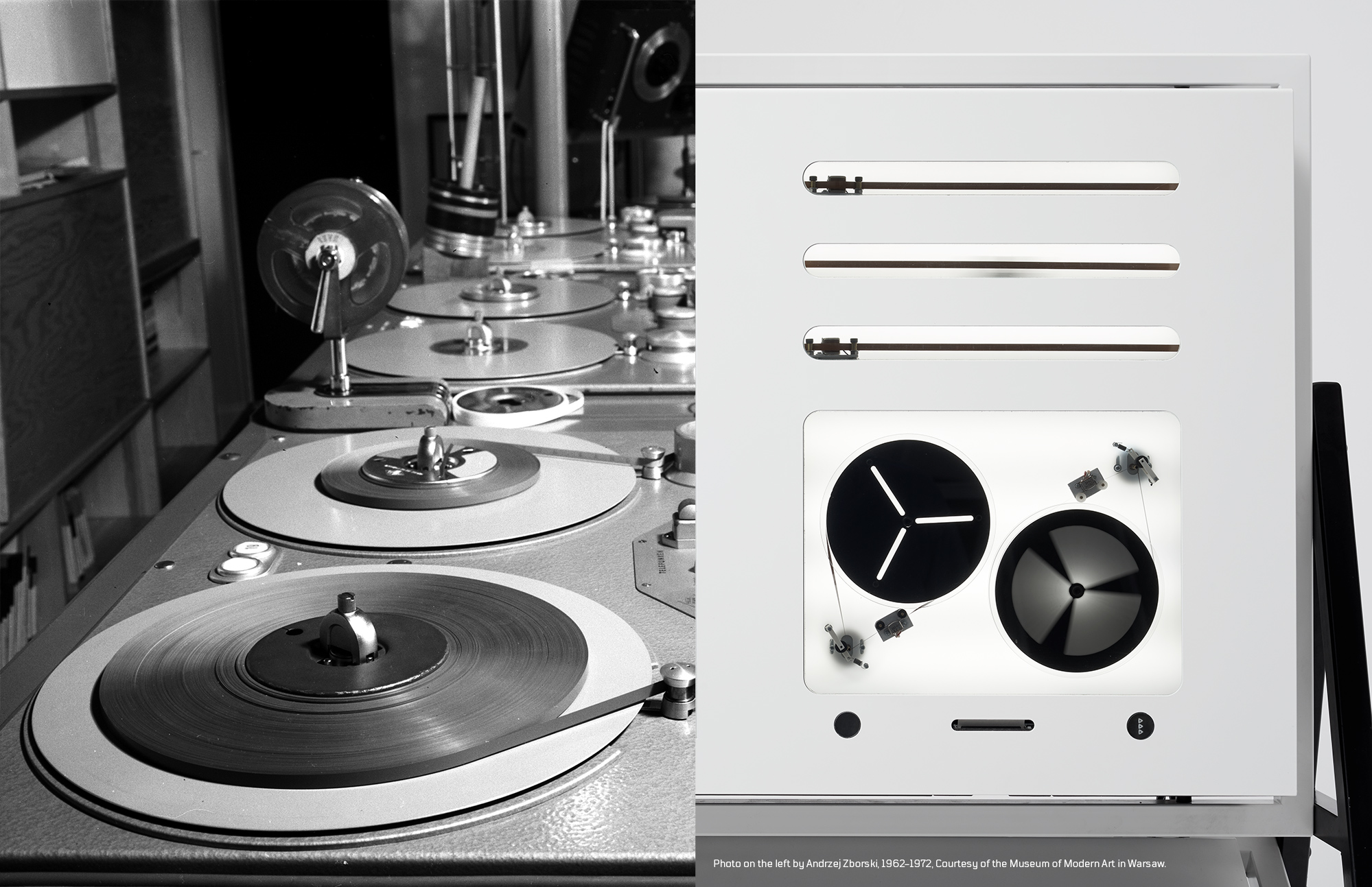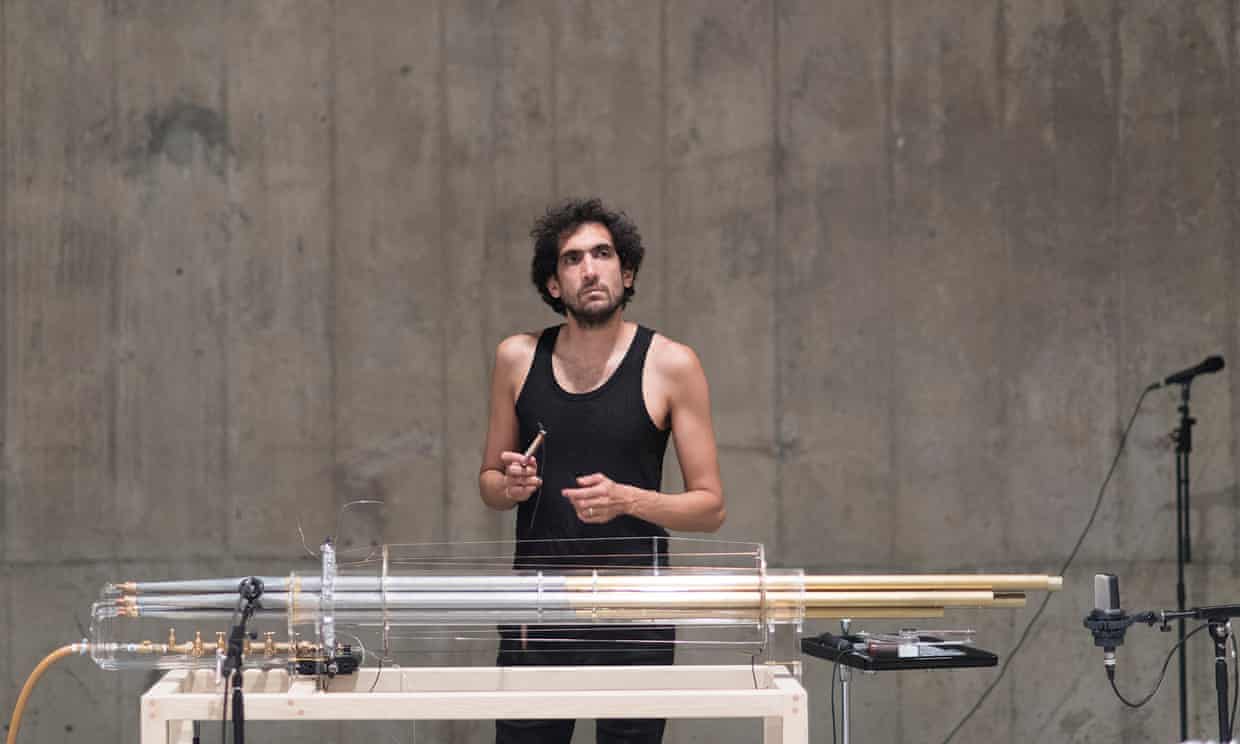I am using one of my grace days on this assignment
sketch
// Alec Albright
// aalbrigh@andrew.cmu.edu
// Section B
// Project 10
var margin = 150;
var radius = 30;
var r = 0;
var g = 0;
var b = 0;
var rotation = 0;
var sine; // sine oscillator
var sineAmp; // sine amplitude
var sineFreq; // sine frequency
var sawtooth; // sawtooth oscillator
var sawtoothAmp; // sawtooth amplitude
var sawtoothFreq; // sawtooth frequency
var square; // square oscillator
var squareAmp; // square amplitude
var squareFreq; // square frequency
function setup(){
createCanvas(640, 480);
angleMode(DEGREES);
useSound();
}
function soundSetup() { // setup for audio generation
// making sine
sine = new p5.Oscillator();
sine.setType("sine");
sine.start();
// making sawtooth
sawtooth = new p5.Oscillator();
sawtooth.setType("sawtooth");
sawtooth.start();
// making square wave
square = new p5.Oscillator();
square.setType("square");
square.freq(440);
square.start();
}
function draw(){
background("white");
fill(r, g, b);
// mapping angle of rotation to mouseY
// as mouse moves up and down, shapes rotate
rotation = map(mouseY, 0, height, 0, 360);
// drawing hexagons with specified margin and rotation
// center
push();
translate(width / 2, height / 2);
rotate(rotation);
hexagon(0, 0, radius);
pop();
// circle around center hexagon
for(let i = 0; i < nvertex; i +=1){
// finding exactly where the hexagon at hand is located
// sin tells us where the y coordinate is
var centerY = sin(angle) * margin;
// cos tells us where the x coordinate is
var centerX = cos(angle) * margin;
// now draw the vertex at hand
// setting up rotation for each individual hexagon
push();
translate(width / 2 + centerX, height / 2 + centerY);
rotate(rotation);
hexagon(centerX, centerY, radius);
pop();
// add the next portion of the angle
angle = angle + (360 / 6)
}
// scaling mouseX to use the whole screen for size
// as mouse moves right, shapes get bigger
radius = map(mouseX, 0, width, 20, 70);
// as mouse moves right, more red, more sine/less sawtooth
r = map(mouseX, 0, width, 0, 255);
// amplitude form 0 to 1
sineAmp = map(mouseX, 0, width, 0, 1);
sine.amp(sineAmp);
// amplitude from .8 to 0 (bigger amplitude on left side)
sawtoothAmp = map(mouseX, 0, width, .2, 1);
sawtooth.amp(1 - sawtoothAmp);
// as mouse moves down, more blue
b = map(mouseY, 0, height, 0, 255);
// as mouse moves left, more green
g = 255 - map(mouseX, 0, width, 0, 255);
// frequency changes depending on whether we're in top half or bottom half
if (mouseY <= height / 2) {
// sine goes from 440 to 1760 Hz (2 octaves) if we're in the top half
sineFreq = constrain(map(mouseY, 0, height / 2, 440, 1760), 440, 1760);
sine.freq(sineFreq);
// sawtooth frequency stabilizes at minumum value
sawtooth.freq(110);
} else {
// sawtooth goes from 110 to 440 Hz (2 octaves) if we're in the bottom half
sawtoothFreq = constrain(map(mouseY, height / 2, height, 110, 440), 110, 440);
sawtooth.freq(sawtoothFreq);
// sine frequency stabilizes at maximum value
sine.freq(1760);
}
// if mouse is pressed, square wave can be changed
if (mouseIsPressed) {
// frequency mapped to the average of mouseX and mouseY, can go from 110 to 440 Hz
squareFreq = constrain(map((mouseX + mouseY) / 2, 0, 640, 110, 440), 110, 440);
square.freq(squareFreq);
// amplitude mapped to the distance from the center of x axis
squareAmp = constrain(map(mouseX - (width / 2), -320, 320, 0, .8), 0, .8);
square.amp(squareAmp);
}
// margin depends on mouseX, keeping same distance throughout
margin = map(mouseX, 0, width, 50, 150);
}
// 6 vertices, as a hexagon has
var nvertex = 6;
// angle we're working at (when we get to TWO_PI, we're done)
var angle = 0;
function hexagon(x, y, radius){
// draw a hexagon at (x, y) using beginShape()
beginShape();
// find each vertex's specific location
for(let i = 0; i < nvertex; i += 1){
// finding exactly where the vertex at hand is located
// sin tells us where the y coordinate is
var vertexY = y + sin(angle) * radius;
// cos tells us where the x coordinate is
var vertexX = x + cos(angle) * radius;
// now draw the vertex at hand
vertex(vertexX, vertexY)
// add the next portion of the angle
angle += (360 / 6)
}
// connect beginning and end points
endShape(CLOSE)
}
For this assignment, I added sonic features to my Project 3 – Dynamic Drawing. I added a sine wave oscillator, a sawtooth wave oscillator, and a square wave oscillator. The mappings for the amplitude and frequency of these oscillators are as follows:
- As the mouse moves from left to right, the sine wave amplitude increases and the sawtooth wave amplitude decreases.
- As the mouse moves from top to bottom on the top half of the screen, the sine wave frequency gets higher (scaling up to two octaves).
- As the mouse moves from top to bottom on the bottom half of the screen, the sawtooth wave frequency gets higher (scaling up to two octaves).
- As the average of mouseX and mouseY increases, so does the frequency of the square wave.
- The closer to the middle of the x-axis the mouse is, the louder the square wave becomes.
Note: the square wave can only be adjusted if the mouse is pressed!!
This process was very interesting in testing harmonic balances in my dynamic drawing, as manifested by these mappings. I certainly see a lot more dimensionality in my drawing now because of the added sound layers!
![[OLD FALL 2019] 15-104 • Introduction to Computing for Creative Practice](../../../../wp-content/uploads/2020/08/stop-banner.png)

